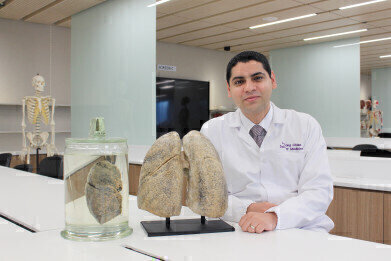-
 Professor Sanjay Chotirmall Credit: NTU Singapore
Professor Sanjay Chotirmall Credit: NTU Singapore
News & Views
Study identifies Bacteria associated with worsening Lung Conditions
Sep 30 2022
In an international landmark study scientists led by Nanyang Technological University, Singapore (NTU Singapore have discovered that Neisseria – a genus of bacteria that lives in the human body – is not as harmless as previously thought, and can cause infections in patients with bronchiectasis, asthma, and chronic obstructive pulmonary disease (COPD).
Bronchiectasis, a long-term condition where the airways of the lungs become abnormally enlarged, is up to four times more prevalent among Asians, particularly the elder population, as compared to their Western counterparts. It can occur following recovery from tuberculosis, but no obvious cause is found in most cases and the condition tends to arise spontaneously and without warning.
To investigate why bronchiectasis worsens at a significantly greater rate among older Asian patients, the international team – spanning researchers and hospitals in Singapore, Malaysia, China, Australia, and the UK– led by NTU’s LKCMedicine Associate Professor Sanjay Chotirmall, Provost’s Chair in Molecular Medicine, matched disease and infection data from 225 patients with bronchiectasis of Asian (Singapore and Malaysia) origin to those from bronchiectasis patients in Europe.
The research team found that Neisseria dominated the microbiome of Asian patients with worsening bronchiectasis, specifically those with predominant amounts of a subgroup of Neisseria called Neisseria subflava (N. subflava) experienced more severe disease and repeated infections (exacerbations) when compared to patients with bronchiectasis without such high amounts of Neisseria.
Upon further investigation using experimental cell and animal models, the research team confirmed that N. subflava causes cell disruption, resulting in inflammation and immune dysfunction in bronchiectasis patients with this bacterium.
Prof Chotirmall, who is also Assistant Dean (Faculty Affairs) at LKCMedicine, said: “Our findings have established, for the first time, that poorer clinical outcomes such as greater disease severity, poorer lung function and high repeated infection rates among bronchiectasis patients are closely associated to the bacteria Neisseria and that this finding is especially important for Asian patients.”
“This discovery is significant because it can change how we treat our bronchiectasis patients with this bacterium. Doctors will now need to think about Neisseria as a potential ‘culprit’ in patients who are worsening despite treatment, and to conduct tests to identify those who may be harbouring this type of bacteria in their lungs. We hope that early identification will lead to personalised therapy, and consequently, better disease outcomes for Asian patients with this devastating disease.”
The bacteria was also found to be present in other more common chronic respiratory conditions such as severe asthma and Chronic Obstructive Pulmonary Disease (COPD).
Using next-generation sequencing technologies, the team were also able to surmise that the indoor living space and potentially the tropical climate may favour the presence of this bacteria in the Asian setting.
Co-author, Professor Wang De Yun from the Department of Otolaryngology at the Yong Loo Lin School of Medicine, National University of Singapore, said, “It is encouraging to see that we have made headway in identifying the Neisseria bacteria species as the cause of worsening bronchiectasis, the unlikely culprit that was
originally not considered to be a threat. This comes as a strong reminder that we should not be too complacent when it comes to doing research and exercise more proactiveness in exploring various possibilities, as every seemingly innocent element could be a source of threat to our bodies and overall health.”
Co-author Andrew Tan, Associate Professor of Metabolic Disorders from LKCMedicine, said, “The reverse translational approach adopted in this work was crucial to our success. Starting from the ‘bedside’ where we studied realâ€ÂÂÂÂÂlife patient experiences, we then worked backwards to uncover the biological process of the bacteria. Thanks to the interdisciplinary nature of the study, the team was able to interact with members from different research disciplines, offering an enjoyable experience while gaining unique insights into the disease.”
The study was published in Cell Host & Microbe, September 14, 2022.
More information online
Digital Edition
Lab Asia 31.2 April 2024
April 2024
In This Edition Chromatography Articles - Approaches to troubleshooting an SPE method for the analysis of oligonucleotides (pt i) - High-precision liquid flow processes demand full fluidic c...
View all digital editions
Events
Apr 22 2024 Marrakech, Morroco
Making Pharmaceuticals Exhibition & Conference
Apr 23 2024 Coventry, UK
Apr 23 2024 Kintex, South Korea
Apr 23 2024 Seoul, South Korea
Apr 24 2024 Jakarta, Indonesia



.jpg)













